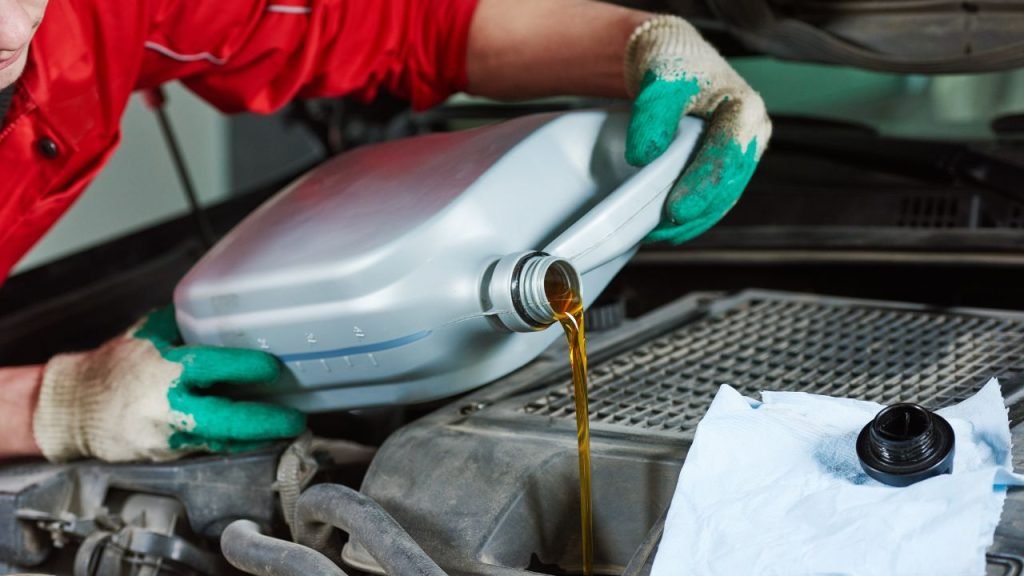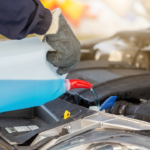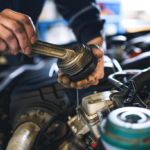Table of Contents
The Importance of Checking and Maintaining Car Fluids in the Summer
Summer is a season that many people look forward to after a long, cold winter. With all the warm weather and long days, it’s a perfect time for road trips or just cruising around town with the windows down.
However, summer heat can put a lot of stress on your car’s components, especially its fluids. That’s why it becomes essential to check and maintain your car’s fluids during this season.
Not maintaining these fluids can have severe consequences such as overheating, engine damage or even accidents. As such, it is crucial to ensure that all of your car’s fluids are at proper levels before embarking on any summer driving.
Brief Overview of The Different Fluids To Check
There are several different types of fluids you should check within your vehicle during the summer months to ensure that they’re working correctly. These include engine oil, coolant, transmission fluid, brake fluid, power steering fluid and windshield washer fluid.
Engine oil is responsible for lubricating the internal parts of your engine so that they can work efficiently without overheating. Coolant helps regulate internal temperatures in hot weather by absorbing excess heat from the engine block before releasing it into other areas.
Transmission fluid is vital for proper shifting between gears and preventing transmission damage from overheating. Brake fluid creates pressure on brake pads so you can stop quickly while driving when needed.
Power steering fluid assists with turning your car wheels easily without strain while washer fluid ensures that debris or dirt doesn’t obstruct your visibility while driving. Keeping track of these essential fluids will save you lots of stress and money in repairs later down the road by preventing significant damages caused by neglecting them during summer months or any other time throughout the year!
Engine Oil: The Lifeblood of Your Car
Your car’s engine oil is essential for keeping the engine running smoothly by lubricating its moving parts. Without it, friction would cause heat and eventually lead to a breakdown.
Checking your engine oil levels regularly is one of the easiest things you can do to ensure your car is running in top condition. To check your engine oil level, park the car on level ground and turn off the engine.
Wait a few minutes to allow the oil to settle in its reservoir, then remove the dipstick from its tube (you should be able to find this with ease by consulting your owner’s manual). Wipe it clean with a rag, then reinsert it all the way back into its tube.
Remove it again and inspect where the oil marks have been made. This will show you how much oil is currently in your car’s system – if it’s running low, top up accordingly.
In addition to checking levels, you should also check the quality of your engine oil. Healthy oil will have a clear amber color and be free from debris or dark patches.
If either of these are present, you should change your car’s oil as soon as possible. Summer driving puts extra stress on an engine due to higher temperatures and more stop-and-go traffic causing more opportunities for wear & tear.
To keep things working optimally during these hot months, it’s recommended that you change your car’s motor oil every 3 months or every 3-5k miles driven (whichever comes first). Regularly changing motor oils helps prevent long-term damage from build-ups of dirt and sludge that can leave lasting damage over time if left unchecked.
Tip:
While checking & changing motor oils during summer might seem like an added hassle on top of other maintenance needs like tire checks or AC service – remember that taking care of smaller details now can save you from major breakdowns in the future!
Coolant: Keeping Your Engine from Overheating
In the hot summer months, your car’s engine has to work extra hard to keep you moving. It’s important to maintain proper coolant levels and ensure that the fluid is in good condition. Coolant, also known as antifreeze, helps regulate your engine’s temperature so that it doesn’t overheat.
Overheating can cause serious damage to your vehicle and even leave you stranded on the side of the road. To check your coolant level, locate the reservoir tank under the hood of your car.
The coolant tank is usually translucent and has “min” and “max” marks on it indicating where the level should be. Make sure your engine is cool before removing the cap to check the fluid level.
If needed, top off the coolant with a 50/50 mixture of water and antifreeze until it reaches the appropriate level. Be careful not to overfill or spill any coolant as it can be dangerous if ingested by pets or wildlife.
Tips for Adding Coolant
If you need to add more coolant than just topping off, there are a few things to keep in mind. First, make sure you use a compatible type of antifreeze recommended for your vehicle by consulting your owner’s manual or talking with a mechanic. Mixing different types could cause damage or decrease effectiveness.
Also, if you’re adding significant amounts of new coolant, make sure to flush out any old fluid first with a radiator flush kit available at most auto parts stores before adding new liquid. This will help refresh all components and prevent clogs that could cause overheating down the line.
Always dispose of any used fluids according to local regulations because they are toxic and harmful when disposed of improperly– never pour them down drains or into water sources! With regular checks and maintenance during summer months – including keeping your coolant levels in check – your car will be road-ready and you’ll have one less thing to worry about.
Transmission Fluid:
Keeping Your Car Running Smoothly
Transmission fluid is essential for smooth driving. It lubricates the gears in your car’s transmission, allowing them to function properly and shift seamlessly. Properly maintaining your car’s transmission fluid can prolong the life of your transmission and ultimately save you money in costly repairs.
Checking Transmission Fluid Levels
To check your car’s transmission fluid levels, start by locating the dipstick. This is typically found near the back of the engine compartment and has a red or orange handle. Pull out the dipstick and wipe it clean with a rag or paper towel.
You want to ensure that there is no debris or dirt on the stick that could give you inaccurate readings. Once the dipstick is clean, reinsert it fully into its holder and then pull it back out again.
Look at both sides of the dipstick to check where the level of fluid sits between “low” and “high.” If it falls below “low,” you need to add more fluid – but be careful not to overfill! Check your owner’s manual for specific recommendations on how much to add.
When to Change Transmission Fluid
Experts recommend changing your car’s transmission fluid every 30,000 – 60,000 miles depending on driving habits and vehicle make/model. However, some newer cars have transmissions that are “sealed” meaning they don’t require servicing as often as traditional transmissions do. If you notice any warning signs like strange noises or difficulty shifting gears when driving, don’t wait until you hit those mileage markers – take your car into a professional mechanic ASAP!
These are signs that something may be wrong with your transmission or its fluid levels. Properly maintaining enough quality transmission fluid will keep gears shifting smoothly while avoiding annoying and potentially dangerous problems such as slipping or grinding gears which can damage the transmission.
The Importance of Brake Fluid in Safe Braking
Brake fluid plays a crucial role in ensuring that your car’s braking system functions properly. This hydraulic fluid transmits pressure from the brake pedal to the brake calipers, which then applies pressure to the brake pads and slows down or stops the vehicle.
Without proper levels of brake fluid or if it is contaminated, your brakes may not work correctly, increasing your risk of an accident. Additionally, hot summer temperatures can increase the pressure and heat on your braking system, causing it to work harder than usual.
This increased stress can cause more wear and tear on your brakes and degrade brake fluid more quickly. That’s why it’s essential to check and maintain your car’s brake fluid regularly during summer months.
How to Check Brake Fluid Level and Condition
Checking your car’s brake fluid is quick and easy. First, locate the master cylinder reservoir under the hood of your vehicle.
This reservoir typically sits atop or near the back of the engine bay on top of a round plastic container with a metal cap labeled “brake fluid.” Use a clean rag or paper towel to wipe away any dirt around this area before opening it. Next, remove the cap on top of the master cylinder reservoir carefully.
Look inside to ensure that you see enough clear liquid reaching at least halfway up between “minimum” and “maximum” level lines on its side walls. If you cannot see anything inside or you see dirty liquid with debris floating in it, these are signs that you need a new brake fluid.
Signs It’s Time To Replace Brake Fluid
In general, you should replace your vehicle’s brake fluid every two years regardless of driving conditions as recommended by most automakers or consult with a qualified mechanic for more information about maintenance schedules specific for their make/model/year combination But if you notice one or more of these signs, it may indicate that you need to replace your car’s brake fluid sooner: – The brake pedal feels spongy or soft when pressed – The brakes are slow to respond and take longer to stop the vehicle than usual
– You hear a grinding noise or feel vibrations when applying the brakes – You notice a significant decrease in braking power during hot weather conditions
Remember, regular maintenance of your car’s brake fluid is essential for your safety and the safety of others who share the road. Don’t hesitate to schedule a maintenance check-up with your mechanic if you’re unsure about how well your car’s braking system is working.
Power Steering Fluid
The Importance of Maintaining Proper Power Steering Fluid Levels
The power steering system in your car is responsible for making it easier to turn the steering wheel, especially at low speeds. The power steering fluid plays a crucial role in this process by providing hydraulic pressure to the system. Without the proper amount of fluid, your car’s power steering will not function correctly, making it more difficult to steer and potentially dangerous.
Maintaining proper power steering fluid levels is essential for keeping your car’s power steering system functioning as it should. If you notice that your car’s power steering is not working as well as it used to or if you hear strange noises when turning the wheel, these can be signs that there is an issue with the power steering system.
In some cases, simply adding more fluid can fix the problem. However, if you continue to experience issues after adding fluid, it’s important to have a mechanic inspect the vehicle.
How to Check Power Steering Fluid Level and Condition
Checking your car’s power steering fluid level and condition is relatively simple and something that should be done periodically. First, locate the power steering reservoir under the hood of your vehicle.
It will typically be marked with a cap that says “power steering” or have a picture of a wheel with an arrow pointing towards it. Next, remove the cap and check where the level of the fluid falls on the dipstick or indicator on the reservoir itself.
The level should fall between high and low marks on either side of dipstick/indicator depending on how old your vehicle is. Also inspecting for discoloration or contamination caused by dirt build up or metal particles from worn out components in engine could lead into damage to other parts like pumps which may lead into costly repairs which could have easily been avoided if checked frequently.
If you find that you need to add more fluid, be sure to use the correct type of power steering fluid that is recommended for your car. Consult the owner’s manual or a trusted mechanic if you are unsure.
Windshield Washer Fluid: Essential for Clear Visibility
As any driver knows, maintaining good visibility is crucial for safe driving. Windshield washer fluid is an important component in achieving this goal.
This fluid helps to remove dirt, grime, and other debris from your windshield, allowing you to see clearly while driving. During the summer months, when bugs and dust are more prevalent on the roads, having a full reservoir of windshield washer fluid is especially important.
Checking your car’s windshield washer fluid level is a quick and easy process. First, locate the reservoir under the hood of your car – it should be labeled with a windshield wiper icon.
Next, check the fluid level by looking at the fill line on the side of the reservoir. If it’s below the fill line, it’s time to add more fluid.
Be sure to use a windshield washer fluid that includes antifreeze if you live in an area with cold winters – this will prevent it from freezing during colder months and clogging up your system. Remember that using plain water can damage your car’s pumps or motor in long run.
Conclusion
Maintaining your car’s fluids during the summer months is essential to keep your vehicle running smoothly and safely on the road. Checking engine oil levels regularly and changing the oil every 3,000-5,000 miles is crucial for engine performance. It is also important to ensure that your coolant levels are at the appropriate level and to add or replace coolant if needed.
Keeping an eye on transmission fluid levels and quality helps ensure smooth driving. Additionally, monitoring brake fluid levels can prevent brake failures, as low fluid levels can cause a loss of brake pressure.
Don’t forget about power steering fluid – maintaining proper power steering fluid levels can prevent damage to the power steering system and help you steer more easily while driving. And lastly, check windshield washer fluid frequently to ensure clear visibility while driving.
By following these simple steps and regularly checking all fluids in your car during the summer months, you will not only prolong the life of your vehicle but also ensure a safer driving experience for yourself and others on the road. So take care of your car’s fluids this summer and enjoy worry-free driving!






